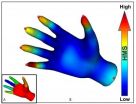(Press-News.org) PROVIDENCE, R.I. [Brown University] — Just like everyone else, people with panic disorder have real stress in their lives. They get laid off and they fight with their spouses. How such stresses affect their panic symptoms hasn't been well understood, but a new study by researchers at Brown University presents the counterintuitive finding that certain kinds of stressful life events cause panic symptoms to increase gradually over succeeding months, rather than to spike immediately.
"We definitely expected the symptoms to get worse over time, but we also thought the symptoms would get worse right away," said Ethan Moitra, a postdoctoral researcher in the Department of Psychiatry and Human Behavior at the Warren Alpert Medical School of Brown University.
But even if the events don't seem to trigger an immediate panic attack, said Dr. Martin Keller, professor of psychiatry and human behavior and principal investigator of the research, patients, family members, or their psychiatrists need to keep their guard up.
"If they have the event and they are not feeling much different then maybe the vigilance on the individual's part decreases somewhat," Keller said. "With the knowledge we have, you may need to stay vigilant for three months or maybe longer. This is something you have to watch for."
In their study, published in advance June 11 in the Journal of Affective Disorders, lead author Moitra, Keller, and their co-authors also found that panic symptoms did not seem to increase in advance of stressful life events, even if they were predictable, such as a divorce becoming official.
The study is based annual assessments of 418 adults with panic disorder or panic disorder with agoraphobia, who were enrolled in the Harvard/Brown Anxiety Research Project (HARP) between 1998 and 2004. Research staff asked the volunteers detailed, standardized questions about important events in their lives and their levels of anxiety.
A statistical analysis of the results found that for stressful life events in the categories of "work," such as a demotion or layoff, or "friends/family/household," such as a family argument, panic symptoms that had meandering severity before the event, increased steadily but gradually for at least 12 weeks afterward.
Stressful events in seven other categories, such as "crime/legal" or "deaths" did not seem to affect panic symptoms at all.
While the findings about the effect of some stressful life events on symptoms of people already diagnosed with panic disorder are new, other researchers have connected stress to panic attacks before. Stressful events are associated with the onset of panic disorder in the vast majority of cases, Moitra said.
Moitra said a possible biological explanation for the association is that stressful life events might exacerbate an underlying proclivity in people with panic disorder to perceive oncoming bouts of hyperventilation, which in turn lead to panic responses.
But while some stressful events have proven to be associated with changes in panic symptom levels, more research is needed to determine what kind of causal role stressful events may have.
"This may be one of those reasons why panic disorders can get worse," Moitra said.
INFORMATION:
In addition to Moitra and Keller, other authors include Brown psychiatry and human behavior researchers Ingryd Dyck, Courtney Beard, Andri Bjornsson, and Nicholas Sibrava. Author Risa Weisberg is also affiliated with the Alpert Medical School's Department of Family Medicine. The National Institutes of Health funded the research.
END
DURHAM, NC – Researchers at Duke University Medical Center have found out how mouse basal cells that line airways "decide" to become one of two types of cells that assist in airway-clearing duties. The findings could help provide new therapies for either blocked or thinned airways.
"Our work has identified the Notch signaling pathway as a central regulatory 'switch' that controls the differentiation of airway basal stem cells," said Jason Rock, Ph.D., lead author and postdoctoral researcher in Brigid Hogan's cell biology laboratory. "Studies like ours will enhance efforts ...
WASHINGTON — Synthetic fat substitutes used in low-calorie potato chips and other foods could backfire and contribute to weight gain and obesity, according to a study published by the American Psychological Association.
The study, by researchers at Purdue University, challenges the conventional wisdom that foods made with fat substitutes help with weight loss. "Our research showed that fat substitutes can interfere with the body's ability to regulate food intake, which can lead to inefficient use of calories and weight gain," said Susan E. Swithers, PhD, the lead researcher ...
Female bosses sometimes have a reputation for not being very nice. Some display what's called "queen bee" behavior, distancing themselves from other women and refusing to help other women as they rise through the ranks. Now, a new study, which will be published in an upcoming issue of Psychological Science, a journal of the Association for Psychological Science, concludes that it's wrong to blame the woman for this behavior; instead, blame the sexist environment.
Belle Derks of Leiden University in the Netherlands has done a lot of research on how people respond to sexism. ...
Richmond, Va. (June 20, 2011) – Researchers at Virginia Commonwealth University Massey Cancer Center have revealed novel mechanisms in mitochondria that have implications for cancer as well as many other age-related diseases such as Parkinson's disease, heart disease and hypertension. This discovery has pioneered the formation of a whole new field within epigenetics research ripe with possibilities of developing future gene therapies to treat cancer and age-associated diseases.
Shirley M. Taylor, Ph.D., researcher at VCU Massey Cancer Center and associate professor in ...
DeKalb, Ill. – Scientists at Northern Illinois University say they have discovered a simple method for producing high yields of graphene, a highly touted carbon nanostructure that some believe could replace silicon as the technological fabric of the future.
The focus of intense scientific research in recent years, graphene is a two-dimensional material, comprised of a single layer of carbon atoms arranged in a hexagonal lattice. It is the strongest material ever measured and has other remarkable qualities, including high electron mobility, a property that elevates its ...
WEST LAFAYETTE, Ind. - Two new techniques for computer-vision technology mimic how humans perceive three-dimensional shapes by instantly recognizing objects no matter how they are twisted or bent, an advance that could help machines see more like people.
The techniques, called heat mapping and heat distribution, apply mathematical methods to enable machines to perceive three-dimensional objects, said Karthik Ramani, Purdue University's Donald W. Feddersen Professor of Mechanical Engineering.
"Humans can easily perceive 3-D shapes, but it's not so easy for a computer," ...
It is a common perception that bigger, stronger, faster organisms have a distinct advantage for long-term survival when competing with other organisms in a given community.
But new research from the University of Washington shows that in some structured communities, organisms increase their chances of survival if they evolve some level of restraint that allows competitors to survive as well, a sort of "survival of the weakest."
The phenomenon was observed in a community of three "nontransitive" competitors, meaning their relationship to each other is circular as in ...
CAMBRIDGE, Mass. — In the 1983 movie "A Man with Two Brains," Steve Martin kept his second brain in a jar. In reality, he had two brains inside his own skull — as we all do, one on the left and one on the right hemisphere. When it comes to seeing the world around us, each of our two brains works independently and each has its own bottleneck for working memory.
Normally, it takes years or decades after a brand new discovery about the brain for any practical implications to emerge. But this study by MIT neuroscientists could be put to immediate use in designing more effective ...
TORONTO, Ont., June 20, 2011--Every second counts when performing CPR.
A new study has found the number of people who survive after suffering a cardiac arrest outside a hospital drops significantly if the pause between stopping CPR and using a defibrillator to administer an electric shock is longer than 20 seconds.
The number of people who survive rises significantly if the pause is less than 10 seconds.
"If your pre-shock pause is over 20 seconds, the chances of surviving to reach a hospital, be treated and be discharged are 53 per cent less than if the pause is ...
BUFFALO, N.Y. -- Frequent use of energy drinks is associated with binge drinking, alcohol-related social problems and misuse of prescription drugs among musicians, according to researchers at the University at Buffalo's Research Institute on Addictions.
In survey results published in the Journal of Caffeine Research this spring, UB research scientists Kathleen E. Miller and Brian M. Quigley examined substance use by 226 Western New York professional and amateur musicians aged 18-45. In the sample, 94 percent were caffeine users and 57 percent reported use of energy ...

